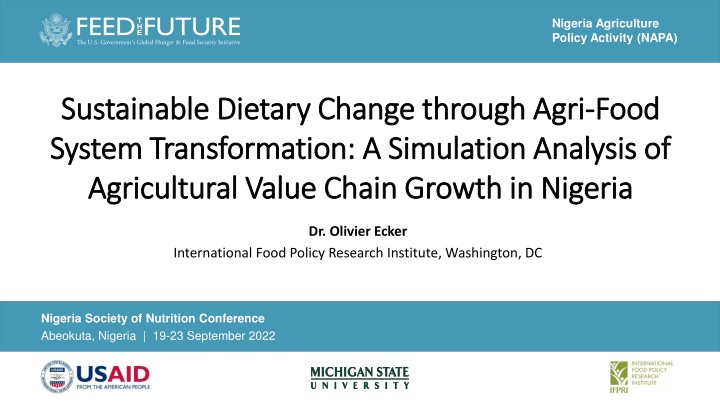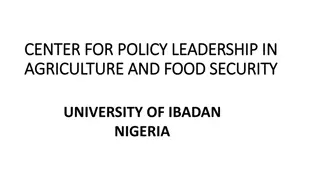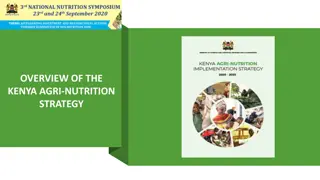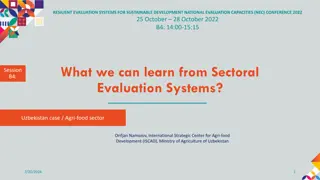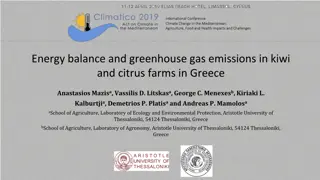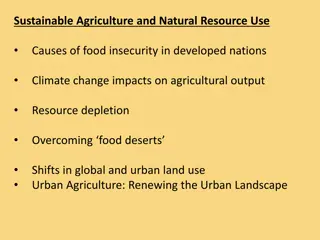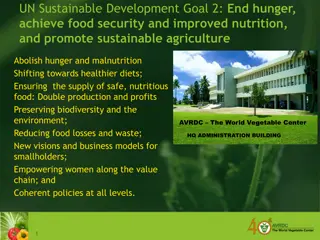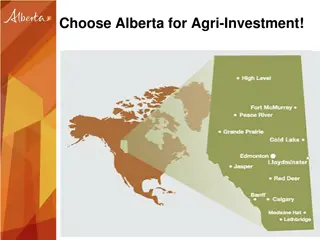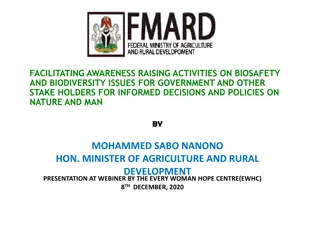Nigeria Agriculture Policy Activity (NAPA) - Sustainable Dietary Change Through Agri-Food System Transformation
Nigeria faces a significant challenge with malnutrition, requiring sustainable dietary changes through agricultural value chain growth. The country's agri-food system needs urgent transformation to support healthier diets and environmental sustainability. Research aims to analyze how agricultural growth impacts dietary outcomes in Nigeria.
Download Presentation

Please find below an Image/Link to download the presentation.
The content on the website is provided AS IS for your information and personal use only. It may not be sold, licensed, or shared on other websites without obtaining consent from the author.If you encounter any issues during the download, it is possible that the publisher has removed the file from their server.
You are allowed to download the files provided on this website for personal or commercial use, subject to the condition that they are used lawfully. All files are the property of their respective owners.
The content on the website is provided AS IS for your information and personal use only. It may not be sold, licensed, or shared on other websites without obtaining consent from the author.
E N D
Presentation Transcript
Nigeria Agriculture Policy Activity (NAPA) Sustainable Dietary Change through Agri Sustainable Dietary Change through Agri- -Food System Transformation: A Simulation Analysis of System Transformation: A Simulation Analysis of Agricultural Value Chain Growth in Nigeria Agricultural Value Chain Growth in Nigeria Food Dr. Olivier Ecker International Food Policy Research Institute, Washington, DC Nigeria Society of Nutrition Conference Abeokuta, Nigeria | 19-23 September 2022
Nigerias nutrition problem and food system challenge Nigeria s nutrition problem and food system challenge Nigeria faces a growing burden of multiple forms of malnutrition:1 Progress in reducing chronic child undernutrition and micronutrient deficiencies has slowed, while overweight/obesity among adults has increased steadily. Poor-quality diets are at the root of all forms of malnutrition and affect human wellbeing beyond nutritional health. Prevalence (%) of different forms of malnutrition in Nigeria3 Child stunting Overweight/ obesity among women 21 22 25 28 Anemia among children 2003 2008 2013 2018 42 41 37 37 Providing a growing population with healthy diets from a sustainable agri-food system is an immediate challenge for Nigeria.2 2010 2013 2018 72 68 68 Broad consensus: Nigeria s current agri-food system does not support consumer food choices for healthy diets and environmental sustainability. Agri-food system transformation is urgently needed. Knowledge gap: How to transform agri-food systems; which interventions are effective in improving diet quality esp. at large scale? 1Ecker et al. (2020). Poor dietary quality is Nigeria s key nutrition problem. FtF Innovation Lab for Food Security Policy Research Brief 119. Michigan State University, East Lansing, MI. 2Ecker et al. (2021). Transforming Nigeria s agrifood system: Wealthier, but also healthier. IFPRI Policy Brief, Nov. 2021. IFPRI, Washington, DC. 3 Based on data from the DHS Program STATcompiler: https://www.statcompiler.com/en/.
Agriculture in the national agri Agriculture in the national agri- -food system food system In Nigeria (and other developing countries), agriculture and agricultural policy have a particular role to play for agri-food system transformation because of the sector s size in the economy and importance for food security. 1 Agri-food system: Share of GDP (%) Primary agriculture Off-farm components Incl. (domestic) ag. inputs, ag. trade & transport, food processing, food services 16 Agricultural value chains are a practical way of framing entry points into an agri-food system for policy and analytical purposes. 11 14 12 12 26 22 18 17 7 7 1 NGA SSA LIC LMIC UMIC HIC 1 Thurlow et al. (forthcoming). Measuring agri-food systems: New indicators and estimates. IFPRI Discussion Paper. IFPRI, Washington, DC.
Research objective and relevance Research objective and relevance Question: How does agricultural growth, driven by different value chains, affect dietary outcomes in Nigeria? Methods: Modeling framework combining an economy-wide model with a household-level food demand system model and a microsimulation model for ex-ante analysis. Innovations: 1. Modeling framework, developed for impact assessments of agricultural and social protection policies and economic shocks. 2. New quantitative measure of diet quality: Reference Diet Deprivation (ReDD) index. Contribution: Quantitative evidence to inform food system policymaking esp. for prioritizing policy options. Add-on analysis: Ranking of agricultural value chains by their simulated impacts across key development outcomes. Healthy diets are only one goal of agri-food system transformation; others include poverty reduction and environmental sustainability. Relative effectiveness of different agricultural value chain (AgVC) growth scenarios may vary across outcome indicators.
Modeling dietary change Modeling dietary change Food consumption analysis based on HH survey data & using food composition tables Food demand system model Estimation for rural/urban areas, based on HH survey data Microsimulation Aggregation to main food groups Observed HH calorie consumption by food item Observed ReDD HH income changes for HH groups in rural/urban areas Economy-wide model (SAM-based) * Simulation of economic effects under a scenario Healthyreference caloric intake by main food group of EAT diet Income & price elasticities for food groups by rural/urban HH groups Predicted HH calorie consumption by food item Predicted ReDD Food price changes for primary & processed food commodities Aggregation to main food groups Baseline scenario: Business-as-usual GDP growth rates to 2025 (from 2017). AgVC growth scenarios: Increase of TFP growth for food products of a %-change from baseline * Here: IFPRI s RIAPA model a country-level CGE model (Diao & Thurlow, 2012). Food demand system model nests a censored QUAIDS (Ecker & Qaim, 2011). Elasticities are available from the E-FooD dataset (Ecker & Comstock, 2021).2 specific value chain to generate 1% additional GDP growth above baseline growth by 2025. Diao & Thurlow (2012). A recursive dynamic computable general equilibrium model. In Diao et al. (eds.). Strategies and priorities for African agriculture: economywide perspectives from country studies. IFPRI, Washington DC. Ecker & Comstock (2021). Income and price elasticities of food demand (E-FooD) dataset: Documentation of estimation methodology. IFPRI Data Paper. IFPRI, Washington, DC. Ecker & Qaim (2011). Analyzing nutritional impacts of policies: An empirical study for Malawi. World Development 39, 412-428.
Reference Diet Deprivation ( Reference Diet Deprivation (ReDD ReDD) index ) index ReDD relates people s dietary patterns to a reference diet to construct a population-level gap measure of diet quality. Approach is adapted from the Multidimensional Poverty Index (MPI).1 EAT-diet reference intakes (kcal/d) per AE 2,500 120 447 Discretionary foods Default: Healthy reference diet of the EAT-Lancet Report.2 International reference diet that meets most people s nutritional requirements and reduces the incidence of NCDs and overall mortality. EAT-diet consists of a balanced mix of plant-based and animal-source food categories, belonging to 6 required food groups plus discretionary foods. Reference intakes are expressed in calories by food group / category. 2,000 Oils & fats Protein foods Dairy foods 726 1,500 Fruits Vegetables Starchy staples 153 1,000 126 Observed dietary patterns: Reported food item quantities are converted to calorie consumption amounts and aggregated by food group. Data: Nigeria General Household Survey Panel (consumption module: 120 food items) 78 500 850 ReDD is based on the required food groups the dimensions of deprivation. 0 1 Alkire & Foster (2011). Counting and multidimensional poverty measurement. Journal of Public Economics 95, 476-487. 2 Willett et al. (2019). Food in the Anthropocene: The EAT Lancet Commission on healthy diets from sustainable food systems. Lancet 393, 447-492.
ReDD ReDD methodology methodology ReDD index is a composite of 3 indicators:1 All estimates for observed ReDD (before COVID). H= headcount rate (share of population deprived in at least one food group) A= avg. deprivation share of the deprived persons G= avg. deprivation gap across all food groups * ReDD = adjusted deprivation gap measure; reflects incidence, breadth, and depth of diet deprivation. Nigeria (nat.): H = 0.998 Nigeria (nat.): A = 0.778 Nigeria (nat.): G = 0.665 Nigeria (nat.): ReDD = 0.517 = H*A*G (Nearly all people are deprived ) (i.e., in about 4.7 out of 6 food groups) * Food group gap = reference intake consumption amounts (compare M1 in MPI) Default: Equal dimensional weights, but relative importance of food group deprivations can be changed (e.g., higher weights for starchy staples in the context of severe food crises). Share of deprived population (%) by food group: Starchy staples Vegetables Fruits Dairy foods Protein foods Oils & fats Nigeria (nat.) 13.3 96.0 90.4 97.0 94.4 75.4 1 Pauw et al. (2021). Costing healthy diets and measuring deprivation: New indicators and modeling analysis. IFPRI Discussion Paper 2073. IFPRI, Washington, DC.
Simulation results Simulation results AgVC growth scenarios: Estimated %-change from baseline in Nigeria at the national level ReDD index Total calorie consumption 0.0% 2.5% -0.2% 2.0% Price effect Income effect -0.4% 1.5% -0.6% 1.0% -0.8% Price effect Income effect 0.5% -1.0% 0.0% -1.2%
Conclusions Conclusions The modeling framework provides a novel, first-cut tool to evaluate ex-ante the likely effectiveness of different agri-food systems-related policies on various development outcomes. The analysis shows that the patterns of agricultural growth matter for diet quality and other outcomes. In Nigeria, agricultural growth driven by dairy and pulse value chain growth has the greatest potential to promote healthy diets. However, increasing food consumption is associated with greater water use. Limitation: The analysis does not (yet) incorporate the costs for achieving the simulated growth patterns, requiring cost-effectiveness assessments. Growing a small sector (e.g., dairy) to generate 1% additional GDP growth likely requires more investments than growing a large sector (e.g., maize). More in-depth analysis is needed to better understand which transformation paths face what kind of constraints, and which value chains are more promising for public and private investments. Complementary to agri-food systems transformation, changes in food environments and consumer behavior at large scale are necessary but are also hard to achieve.
